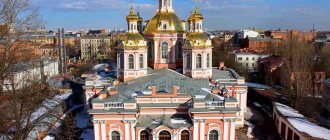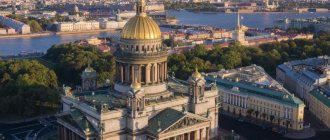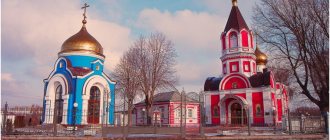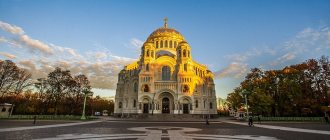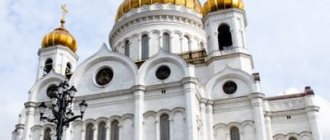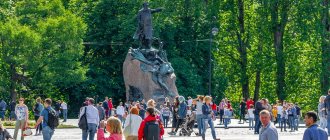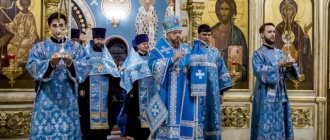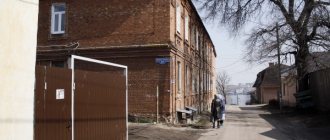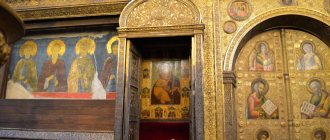Predecessor temples
In the first half of the 18th century, St. Petersburg was a very small city. On the site of modern Ligovsky Prospekt there was a road to Novgorod - the only road that connected the banks of the Neva with Russia. Families of coachmen lived next to the road, and gradually the Yamskaya Sloboda was formed here.
Orthodox Christians did not have their own church, so in 1710 they built a small chapel in the local cemetery. However, three years later the wooden building burned down in a fire.
The coachmen collected funds, drew up a petition, and in 1718, after permission from the archimandrite, they erected a small church in the churchyard in honor of the Nativity of John the Baptist. The one-story temple looked very modest. The elongated building had a high sloping roof and a narrow spire with a cross.
View of the Holy Cross Cathedral
After some time, a wooden belfry appeared nearby, but there were no bells for it. These were the years when, by order of Peter I, “extra” bells from Russian monasteries were brought to St. Petersburg and cannons were cast from them. The four bells were not given to the foundry workers, but were hung on the new bell tower.
In 1730 there was another fire. The raging fire burned the wooden temple to the ground. Devastated parishioners collected money and bought the old chapel at the Okhtinsky factories. So another wooden temple appeared on the ashes.
Unfortunately, his life was not long. The wooden building quickly fell into disrepair. After a few years, the walls became dilapidated and the roof began to leak when it rained. Distressed parishioners of Yamshchitskaya Sloboda drew up a new petition to the diocese and asked to be allowed to build a stone church.
Facade of the Holy Cross Cathedral
Interior decoration
The interior of the temple is a spacious central nave with a white marble altar of the 15th century on ancient columns of the 6th century. In the center there is a large platform for the choir, fenced with marble bas-reliefs of the 16th century by famous artists depicting the deeds of the Saint.
In the cathedral there is an altar consecrated in honor of Saint Severus, a contemporary of Saint Eulalia, who was also killed by Christian persecutors for his faith. Behind the fence are wooden carved chairs with gilded coats of arms of the Medieval Knights of the Order of the Golden Fleece. 2 side limits separated by graceful thin colonnades.
Many 15th-century stained glass windows adorn the window openings. In the corner to the right of the Main Chapel of the cathedral there is a Treasury with unique objects of church art.
Barcelona Cathedral Interior – carved choir stalls
There in the 3 rooms of the sacristy you can see:
- reliquary of Charles V with a chain of the order of knighthood from the 15th century;
- 14th century ceremonial gilt silver cross;
- one of the most beautiful swords in the world - Pedro of Portugal;
- gilded throne of the Aragonese king Martin I;
- precious ark for gifts from the 14th century.
Inside the cathedral there are 26 unique chapels of amazing fine workmanship. Particularly noteworthy is the Chapel of the Transfiguration with its magnificent reliefs. The main chapel of the temple, the Major, also stands out. On the chapel of St. Oligaria there is an ancient forged lattice from the beginning of the 15th century.
Behind it is the Chapel of Saint Clement, where the sarcophagus of Doña Sansa Ximenis de Cabrera is kept. The Chapel del Santo Cristo de Lepanto is recognized as one of the best examples of Gothic architecture. The Chapel of St. Miguel will display a 14th-century altar with a painting on the subject of “The Visit.” Each of them is a small museum with unique objects and history.
History of the cathedral in the 18th-19th centuries
The bureaucracy in Russia has been strong at all times. It took more than 15 years to obtain various approvals and collect the necessary funds. The construction itself took two years.
History has not preserved the name of the author of the project, but according to documents it is known that the workers were led by the German architect Johann Jacob Schumacher. He was an experienced architect who had already erected several civil buildings and churches in St. Petersburg. In 1749, the new temple was ready, and it was consecrated in honor of the Feast of the Exaltation of the Holy Cross.
In the 60s of the 18th century, the warm Church of the Tikhvin Icon of the Mother of God appeared nearby. It was built with the money of the merchant I. Ilyin.
At the beginning of the 19th century, architect Alexander Ivanovich Postnikov prepared a project for a high bell tower. By 1812, construction was completed. A four-tiered gate tower with a spire appeared in front of the two temples, and it immediately became the architectural dominant of the city.
Bell tower of the Cathedral of the Exaltation of the Cross
In the 1850s, the cathedral experienced a rebirth. The talented architect Yegor Ivanovich Dimmert completely rebuilt the building in the best neo-Baroque traditions. At the same time, he preserved part of the walls and foundation of the stone temple of the 18th century. The stucco work for the renovated cathedral was carried out by the skilled craftsman Timofey Dylev, and the icons were painted by the isographer Korotkov.
From 1856, for 18 years, the rector of the temple was the famous educator and teacher John Konstantinovich Yakhontov. Thanks to his efforts and the sponsorship of the merchant I. I. Shigalev, the Church of Cyril and Methodius appeared under the arches of the church bell tower. The architectural design for the small church was prepared by Ludwig Fedorovich Buglieri.
Year after year, St. Petersburg grew and expanded. The Ligovskaya side has not been a suburb for a long time, and the name “Yamskaya Sloboda” remains only in the memory of historians. Residents of Ligovka and Cossacks who performed military service in the city came to the temple to pray.
At the turn of the 19th-20th centuries, the cathedral parish was one of the largest in the diocese. It numbered more than 14 thousand people. At the temple there was a Society for Aid to the Poor, an almshouse for elderly women, a free canteen, a shelter for children and a parochial school.
Architect and exterior decoration of the cathedral
Architect Jaume Fabre conceived the cathedral in the style of early Byzantine church architecture with the introduction of pronounced Gothic elements, and later the author’s plan was complemented by the neo-Gothic style. Architects Bertrand Ricoeur and Arnau Bargues also worked on the long-term building. The cathedral was partially erected on the ancient foundation of the previous temple.
Despite its impressive size, the building does not seem heavy, but gives the impression of lightness and elegance. The cathedral is crowned with 5 pointed towers: a large central one and 4 around it.
The walls of the temple are decorated with many narrow buttresses topped with spiers; mascarons, harpies, snails, stone flowers and lion heads complete the decoration. Many sculptures and statues in wall niches, bas-reliefs and patterned capitals. A characteristic feature of the decoration of the facades are carved stone trim and frames with elegant floral patterns and flowers.
You can enter the temple through several entrances:
- the oldest gate of St. Job;
- portal of St. Lucia;
- Saint Eulalia;
- Pietat.
The fate of the temple in the 20th century
After the revolution, the cathedral was not immediately closed. Divine services continued until the early 1930s, when mass persecution of believers began in the country. First, the city authorities liquidated the Tikhvin Church. The religious building was given over to a school. Then production workshops were created here, and part of the premises was given to the radio engineering college.
In 1938, it was the turn of the Holy Cross Church. During the repressions, eight priests were shot, and the cathedral was closed to parishioners for a long time. The building was converted into a film storage facility. New warehouse floors and cross beams significantly distorted the interiors and disfigured the temple.
Then the war began. During the artillery shelling of Leningrad, several shells hit the cathedral. However, this was not the only problem. In the first winter of the blockade, the bodies of Leningraders who died of hunger were brought to the temple. They were not buried because it was terrible cold. Only in the spring of 1942 did the dead residents of the city receive their last refuge at the Volkovsky cemetery.
After the war, restoration workshops were located in the cathedral. For several years, heavy woodworking machines and lathes stood inside. The floor was covered with a thick layer of asphalt, there was a bathhouse in the vestibule, and workers undressed in the altar.
Sculptures of the apostles Paul and Peter in the niches of the cathedral bell tower
In 1991, the ancient building was transferred to the Cossack parish of the city. According to the documents, the condition of the temple was assessed as “ruins”. It looked like a huge barn with half-collapsed plaster.
First, it was necessary to clear the area of debris and raise money for construction materials. The first service was held in 1993. Large-scale restoration of all church buildings took more than 10 years.
Crosses on domes: a unique collection of Inver Sheydaev
During the Week of the Cross, we figure out what a cross on a church should look like. Photographer Inver Sheydaev devoted his entire life to collecting a collection of photographs of domed crosses of various shapes. We publish the most interesting pictures.
The village of Nikolo-Arkhangelskoye. St. Nicholas-Arkhangelsk Church (XVIII century) We express special gratitude to the authors of the book “Russian Cross. Symbolism of the Orthodox overhead cross" to Marina Anashkevich and Invrera Sheidaev for the opportunity to truly appreciate the heavenly beauty, which we rarely look closely at in ordinary life. The main part of this collection was collected during the Khrushchev “thaw”, and then the Brezhnev “stagnation”. The first exhibition took place in 1968, but was immediately closed. Only in the 90s the collection received recognition and was shown not only in Russia, but also in Paris. For thirty years, photographer Inver Sheydayev traveled through the cities and towns of the then Soviet Union and photographed the crosses crowning the heads of Russian churches, the crosses at the head. What did he have to endure on these travels? Once, by some miracle, he even persuaded the men of one distant village to dismantle the scaffolding surrounding the dome of the temple in order to photograph the cross. It all started in the office of the famous Pyotr Dmitrievich Baranovsky (1892-1984), where the young photographer showed his work to the famous restoration architect. Then Inver was fascinated by the decorative elements of temples. One day Pyotr Dmitrievich said: “This is full of everything. You better look up. Take off the crosses. No one has ever photographed this beauty before. Collect crosses, sooner or later you will need it, you’ll see.” These words turned out to be prophetic. Later, Inver was approached more than once with “orders” for crosses. He took photographs for the restored churches on Solovki, for the churches of Tobolsk and other cities. The collection turned out to be invaluable at a time when people began to “collect stones.” Many crosses were restored using photographs from this collection. Unfortunately, many more destroyed churches, the crosses of which Inver photographed, still stand, overgrown with forests, decapitated. Pyotr Dmitrievich Baranovsky, who has seen many churches in ruins in his lifetime, said: “Why is the cross destroyed in the first place? Because he, like a mother’s breast, nourishes.” LILY AND GRAPES Crean is a stylized image of a lily flower, a symbol of purity. Such krinas were usually made at the ends of the “branches” of the cross, because the three leaves of the lily (krin) testify to the One Holy Trinity in three Persons.
Moscow. Novodevichy Convent. Cathedral of the Smolensk Icon of the Mother of God. (1525) A vine entwined with a cross with bunches of berries is a symbol of the Living Christ. “I am the true vine, and My Father is the vinedresser” (John 15:1). Vologda blacksmiths were especially successful in forging grape ornaments on the head crosses. Cross of the Church of Demetrius of Prilutsky of the Spaso-Prilutsky Monastery in Vologda. And one can be amazed at how subtly the masters conveyed the symbolic connection between the vine and Holy Communion. This headpiece has a crescent moon at the bottom, symbolically representing the Chalice.
Vologda. Church of Demetrius of Prilutsky Spaso-Prilutsky Monastery.
Vologda. St. Sophia Cathedral (1568-1570) DOVE Dove, symbol of the Holy Spirit from time immemorial. “... and John saw the Spirit of God, which descended like a dove...” (Matthew 3: 16) This bird itself, frozen in flight, has the appearance of a cross.
Cross of the Church of the Myrrh-Bearing Wives Martha and Mary in Novgorod (1510). If you look closely, you can see in the openwork heart of this cross a dove with outstretched wings. But such an image is the only one, mostly doves were cast and crowned with a cross. In ancient times, doves on the cross sometimes also showed which direction the wind was blowing; they were called windbirds.
Velikiy Novgorod. Saint Sophia Cathedral. (1049-1050) This cross and the dove on it have their own legendary history. There is a prophecy that Veliky Novgorod will exist as long as the dove is on top of the cross of Hagia Sophia. In 1942, during the Great Patriotic War, the cross from Hagia Sophia was thrown off by a blast wave. He was taken out of Russia by soldiers of the Blue Division, a Spanish unit of the German army. Instead of the lost shrine, a “double” cross was subsequently installed on the main dome of Sofia; the original was kept in Spain, in the temple gallery of the Military Engineering Academy near Madrid, where it was installed in a prominent place. For more than 60 years, more than one generation of Spanish Christians prayed in front of this Russian shrine. Next to the cross was a memorial plaque with the names of sappers who died in Russia. In 2004, the cross returned to its homeland - Spain voluntarily handed it over to Russia. It was brought to Moscow by the Spanish Minister of Defense, and the cross was solemnly greeted in the Cathedral of Christ the Savior. Now it is kept in one of the chapels of the St. Sophia Cathedral. SOURCE OF LIFE Thriving shoots If shoots grow from under the base of the cross, then it is called “flourishing”. The shoots symbolize rebirth, the Resurrection of Christ from the dead. Ascended into the heavens, the overhead “flourished” crosses showed for the Russian people a visible image of the Garden of Eden and the tree of life growing in it. Some of these crosses are completely strewn with flowers, so it is impossible to look away. They truly resemble plants in a spring garden; the plant elements were chosen with such artistic flair.
Moscow. Church of the Intercession of the Virgin Mary in Fili (1690-1693). Drops of Blood Copper bulges - “dewdrops” and beads on the chains mean drops of blood shed by the Savior on the cross. In Rus' they were also called “tears”.
St. Petersburg. Church of the Resurrection of Christ "Savior on Blood") (1883-1907), built on the site of the assassination of Emperor Alexander II in 1881. VOLUNTARY SACRIFICE Cane and spear
Kirillov. Kirillo-Belozersky Monastery. Church of John Climacus (1572). A cane with a sponge and a spear - instruments of the Passion of the Lord - are a frequent occurrence on domes. The main cross with the instruments of the Passion seems to replace the Crucifixion, which cannot be on the dome (it is located inside the temple). But the realism of the Savior’s terrible agony on the cross should not overshadow the main thing - the triumph of the Crucified Redeemer, who defeated death. The lily flowers that complete the cross “branches” speak of this in the best possible way.
Pskov region, village of Videlebye. Church of St. Nicholas the Wonderworker (XVI century) The spear and sponge are stylized as two flowers that bloomed on the cross.
Now above the head of the already restored church, its cross rises again. THE HEAVENLY KING Crown The crown on top of the main cross symbolizes the Cross of the Heavenly King and indicates to us that the church was erected by order of the king of the earth, or with donations from the royal treasury. The crown can be either quite real or very conditional.
Ryazan. Spassky Monastery. Church of the Epiphany (1647)
Moscow. Church of the Deposition of the Robe in Leonovo (1719-1722) Sovereign scepter The cross can also symbolize the second sign of the royal power of Christ - the scepter. Giving the cross the appearance of a scepter is possible with the help of one well-known symbolism. The top of the scepters of the Russian tsars was the figure of a crowned double-headed eagle - the sovereign sign of Byzantium. However, domes with a double-headed eagle were installed on churches only in the era of Peter I, a tsar known for his imperial ambitions.
Moscow. Church of the Intercession of the Virgin Mary in Fili (1693). In unity and equality, a four-pointed cross (usually with a crescent at the bottom) has been placed on the domes of churches since ancient times. This type of cross symbolizes the Church of Christ in the unity and equality of its visible and invisible sides. Over time, there were detractors of the four-pointed cross, they said that this was the wrong cross, because it was not the one on which Christ was crucified. But Saint Demetrius of Rostov put an end to this dispute. He suggested that when Christ carried the cross on His shoulders, the cross was not yet four-pointed, because there was no title or foot on it yet, and only on Golgotha the soldiers, not knowing where Christ’s feet would reach, attached a foot.
Vladimir. Cathedral of the Assumption of Our Lady (1158-1160)
Tula region, Arsenyevsky district, village of Monaenki. Church of St. George the Victorious (XIX)
And this is what the temple looks like now. The cross was preserved only in a photograph by Inver Sheydaev. Russian Foot One of the oldest Russian crosses is six-pointed with an oblique lower crossbar. The oblique foot symbolically represents the crossbar of the “scales” of the Last Judgment. Some researchers of Christian symbols and, in particular, N.V. Pokrovsky suggest that the oblique crossbar is nothing more than a modified form of the ancient Byzantine foot of the cross. One way or another, this form became established in Russian icon painting. The oblique crossbar was given the meaning of “the measure of the righteous.” And people began to call the foot “stood”.
Vologda. Bishop's House. Church of the Nativity of Christ (1670) That same Seven-pointed Cross, a T-shaped cross, apparently was the oldest form of the Christian cross, since this is exactly what the cross, the instrument of execution of the Savior, looked like. This cross has the appearance of an altar, due to the top crossbar, which looks like a throne. The Old Testament priests made sacrifices on a golden stool attached to the throne, therefore, if the upper crossbar symbolically represents the altar, then the lower crossbar of such a cross signifies this stool of the cross and points to the sacrificial priestly service of the Savior.
Moscow. Kremlin. Church of the Twelve Apostles (1652-1656) HEAVENLY POWERS Sun and stars Straight or wavy lines emanating from the center of the cross convey the radiance of the sun. Straight rays indicate direct light, and wavy rays indicate combustion and heat. The motif emanating from the cross of the “light of life” is conveyed by each artist in his own way.
Pskov region, Loknyansky district, village of Dunyani. Church of the Archangel Michael (XVI-XVIII centuries) Such a cross is very rare.
The temple itself is now ruins. The cross is lost. Often the ends of the rays were also decorated with stars.
Nizhny Novgorod. Church of the Nativity (1719)
Tobolsk Church of the Seven Youths of Ephesus. (XVIII century) Lightning “Like lightning seeing the power of the cross” the evil forces flee from the cross. That’s why lightning can be found on temple crosses.
Moscow region, Odintsovo district, Yudino village. Church of the Transfiguration of the Lord (1720)
Angels and Cherubs By attaching a copper angel to the cross, the author emphasized that the temple also has a guardian angel. The most famous and traditional are angels carrying a cross, like a banner, as on the spire of the Cathedral of the Peter and Paul Fortress in St. Petersburg.
Ryazan. Church of the Entry of the Lord into Jerusalem (XVII) Often in the main crosses there are images of Cherubim.
Moscow region, village of Komyagino. Church of Sergius of Rajonezh
Now the church has been completely restored. EARTHLY HAVEN Ship and anchor Our most ancient temples, on the heads of which a cross with a crescent flaunts, are the Annunciation Cathedral of the Moscow Kremlin, the Novgorod St. Sophia Cathedral and the Demetrievsky Cathedral in Vladimir. The crescent is a church ship, led by the helmsman Christ.
Moscow. Church of the Assumption of the Mother of God in Gonchary. In the 19th century, the theme of a sailing ship was no longer limited to just the crescent symbol. Thus, in the cross of the eight-pointed cross of the Church of the Resurrection of Christ on the Obvodny Canal in St. Petersburg, the steering wheel of a sea vessel is depicted, and instead of a semi-lunar one we see an oblique foot. If the ship is anchored, then in terms of its safety it is as if already on the ground. And although the waves rock it, they cannot drown it. It is almost impossible in many cases to distinguish the domed cross on the “lunar base” from the “anchor” cross. The only detail that unmistakably points to an “anchor” is all kinds of decorations and thickenings at the ends of the arc.
Moscow region, Lukhovitsky district, Didinovo village. Church of the Life-Giving Trinity
Between Heaven and Earth The place of intersection of the horizontal with the vertical on the cross, the place of the middle cross, symbolizes the intersection of the human with the divine. The cross is a mediator between earth and heaven. Therefore, this place on the cross was often decorated with a “figure eight”, shaped like a keyhole. It is formed by the addition of two symbols - a halo (the radiance of holiness) and a tsata (a precious pendant denoting royal “purity”).
Moscow. Church of the Resurrection of Christ in Kadashi (1687-1713) The article uses materials from the book “Russian Cross. Symbolism of the Orthodox overhead cross." Moscow, “AST”, 2006.
Prepared by Irina Sechina
print version
Tags:
Church Temple Ecclesiastical art
Architectural features
The entrance to the territory of the cathedral complex is located from Ligovsky Prospekt. Tourists and pilgrims are greeted by a slender bell tower with a spire. It rises to 60 m and is therefore clearly visible from the surrounding areas.
Two arched spans with paired columns connect the bell tower with low chapels. Sculptural images of the apostles Paul and Peter are installed in the niches. At the top you can also see eight statues of the apostles.
Cathedral domes
The central place is occupied by the ancient Holy Cross Cathedral. The Baroque Orthodox church looks very festive. This is exactly how they built in Rus' during the reign of Empress Anna Ioannovna.
The temple has the shape of a Latin cross and a semicircular apse. The building is 53 m long and 35 m wide. Together with the cross, the cathedral rises 41 m. Five expressive Baroque domes rest on large light drums.
Cradle of Baby Jesus
The figure on the cross also has a third interpretation: the inverted crescent moon resembles the cradle of the baby Jesus. There is also an opinion that the crescent moon is similar to the Eucharistic cup in which the Body of Christ is located, to the church ship and to the baptismal font.
Father Andrei (Posternak), a candidate of historical sciences and a priest , told AiF.ru that this symbol really has many interpretations. In his opinion, the most correct version is that this crescent symbolizes the Eucharistic cup.
“The cross stands, as it were, above the semicircle of the Eucharistic chalice. This is not exactly a crescent moon, it is a truncated image of the cup that the Savior gave to his disciples at the Last Supper. Thus, this is one of the most important symbols associated with the sacrament and with the suffering of the Savior. Such ambiguous symbols will always have many different interpretations depending on the conditions in which this occurs and on the historical era. In my opinion, the most correct explanation is historically associated with the top of the bowl. Because it clearly has more ancient roots and has nothing to do with polemics with Islam,” said Father Andrei.
Interiors and shrines
The inside of the cathedral is spacious and bright. The walls and ceilings are covered with paintings depicting scenes from the Holy Scriptures and the faces of saints. The northern aisle of the temple is dedicated to Prince Alexander Nevsky, and the southern aisle to the holy Royal Martyrs.
Church in the name of the Tikhvin Icon of the Mother of God
There are many icons in the cathedral. Parishioners venerate military relics - the ancient image of the Great Martyr George, the banner of the Cossack brotherhood, the Imperial flag and the banners of the Don and Kuban troops.
A special shrine is the icon of Our Lady of Tikhvin, painted in the mid-19th century.
The beautiful icon case is decorated with embroidered chasuble and jewelry, which were brought as gifts by believers. Many come to pray near the reliquary, where pieces of the relics of Christian saints, apostles and martyrs for the faith are kept.
Address of the Cathedral of the Holy Cross and Saint Eulalia in Barcelona
The residence of the Archbishop of Barcelona since the 15th century is located in the main church dedicated to the patron saint of the city. Finding the Cathedral will not be difficult. It is located in the Gothic Quarter of the Old Town of Barcelona. It is reached by the pedestrian street Carrer del Bisbe.
Cathedral address: Pla de la Seu 3, 08002 Barcelona.
How to get there by car
The exact coordinates of the temple for those traveling in a personal car with a navigator: 41°23'03.0″N 2°10'34.5″E.
How to get there by public transport
The famous Catholic church can be easily reached by public transport in several ways:
- by metro, take the yellow line to Jaume I station;
- on regular buses No. 17, 19, 40 and 45;
- by special tourist bus, blue route to Barri Gòtic station.
Useful information for visitors
The Holy Cross Cathedral is open any day from 9:00 to 20:00. You can enter the Tikhvin Church only during services. The Temple of Cyril and Methodius is accessible in the warm season. The chapel on Ligovsky Prospekt is open from 10:00 to 14:00 and from 15:00 to 19:00. Church services are held at 10:00 and 17:00.
In the cathedral fence, from 10:00 to 19:00, there is a shop that sells honey, medicinal herbs and tinctures. Excursions to the parish churches are conducted for pilgrims.
Monument to the holy Tsar-martyr Nicholas II and his family on the territory of the parish of the Holy Cross Cossack Cathedral
Reviews
Restoration work began in 2008 and is still ongoing. During this time, the historical appearance of the bell tower was restored, the dome was gilded, and work began on the roof. Today, every believer or connoisseur of St. Petersburg architecture can come to the cathedral. A monument to Nicholas II was erected on the territory of the temple in 2002, and St. Petersburg residents reverently preserve the memory of the last Tsar of Russia. In 2001, the southern aisle of the temple was consecrated in honor of the Holy Royal Passion-Bearers.
One of the dominant features of Ligovsky Prospekt is the Holy Cross Cathedral (St. Petersburg). Reviews from visitors talk about the extraordinary beauty of the temple, the unusualness of its architecture, where the bell tower is united by a gallery with two chapels, and the courtyard is filled with peace and quiet, shining with ancient St. Petersburg architecture, respect for history and attention to modern life.
Regrets in the reviews concern only the slow progress of restoration work. Many people express the opinion that the location of the temple away from tourist trails makes it interesting for lovers of non-trivial walks around St. Petersburg.
History of appearance
In the Orthodox religion, the crescent on the cross is usually called tsata. Tsatsa decorated crosses on churches at the beginning of the second millennium. They can be seen on one of the oldest churches that have survived to this day - the Church of the Intercession on the Nerl (1165).
Since ancient times, this Byzantine symbol denoted royal power. Therefore, the crescent was placed on the image of the Kyiv prince Yaroslav in the “Royal Chronicler” back in the 16th century. And only after the conquest of Constantinople by Turkish troops, this symbol was “pumped” into Islam. You can also see the crescent moon on icons of saints. For example, on the vestments of Nicholas the Wonderworker, as well as the Savior Jesus Christ Himself and His Mother, the Most Holy Theotokos and the Ever-Virgin Mary.
Today, historians do not undertake to assert the exact time of the appearance of tsata, but it is known for certain that such a symbol was present in Christianity even before the baptism of Rus' by Prince Vladimir.
